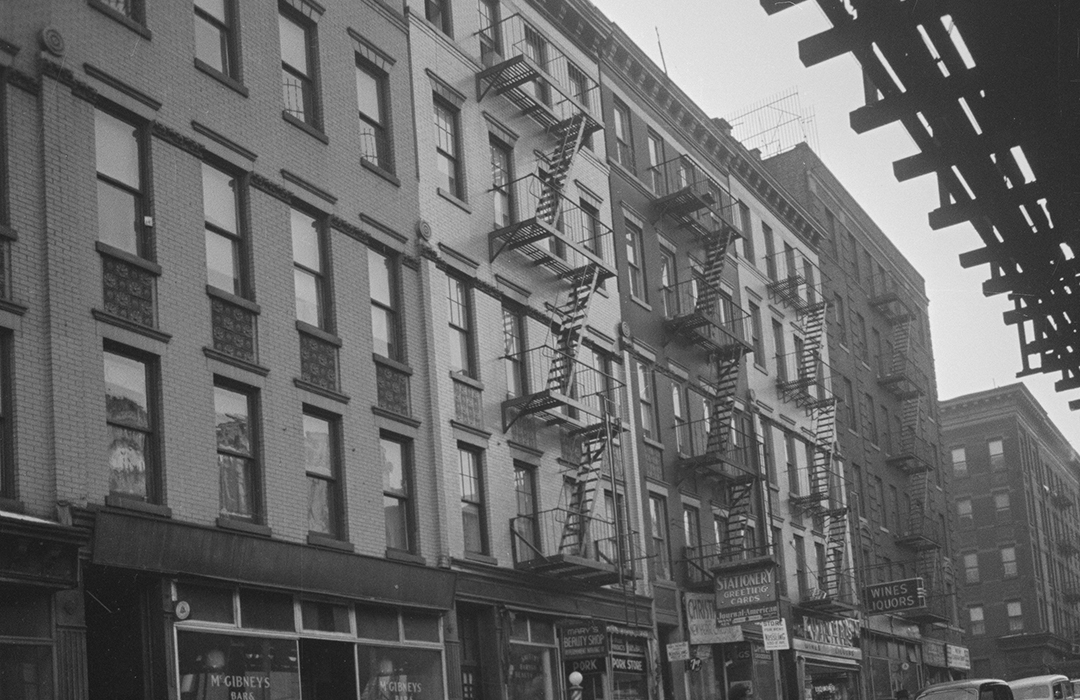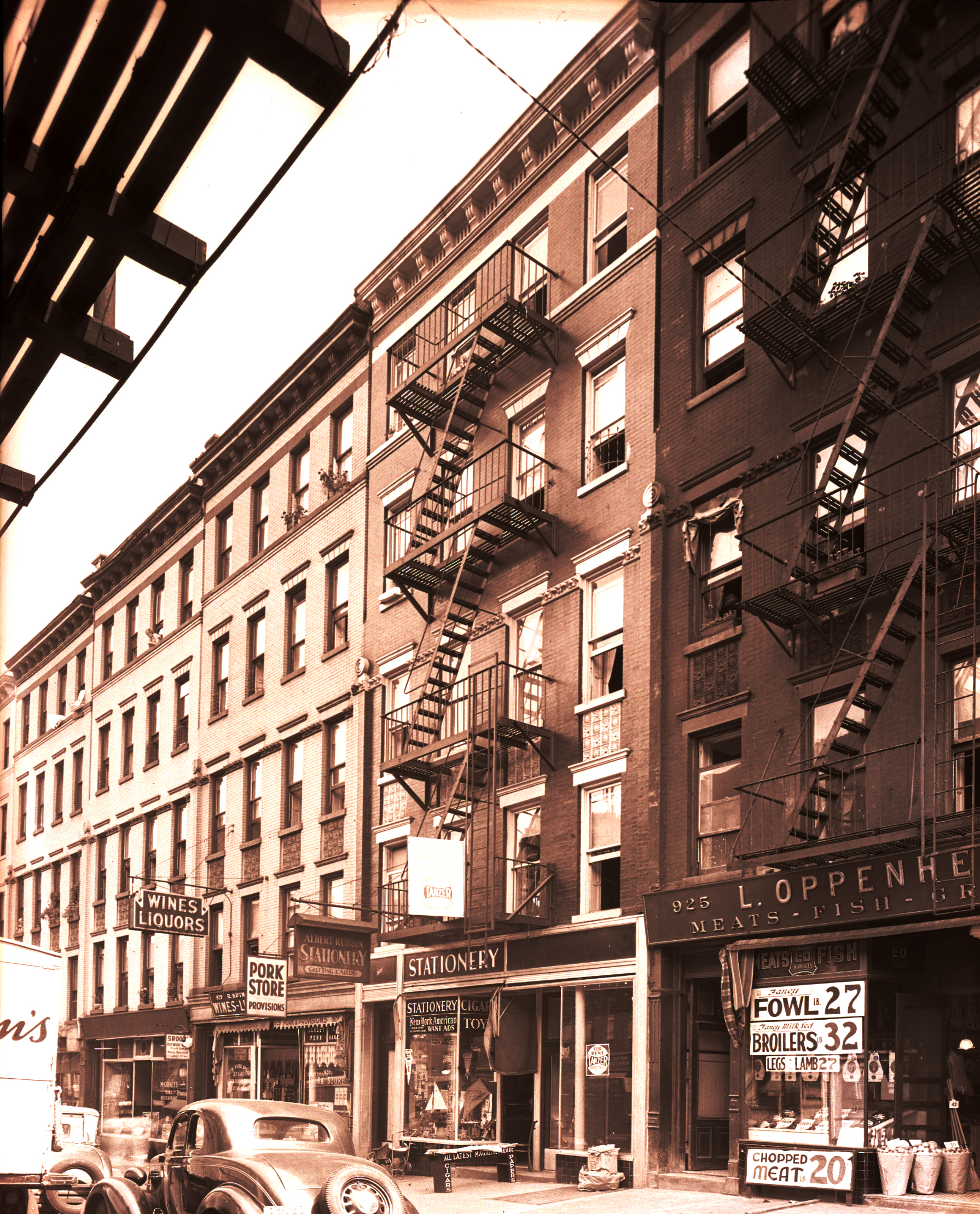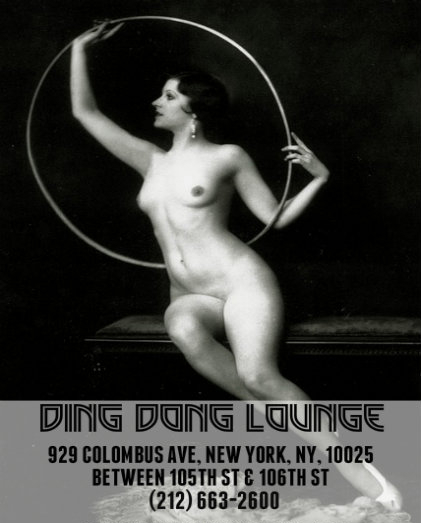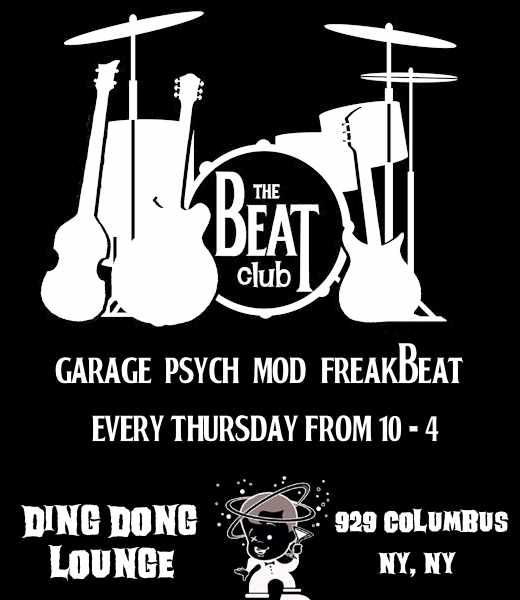
This One Takes the Cake
by Tom Miller, for Sarah McCully
By 1890 development of the Upper West Side had reached as far north as the Manhattan Valley neighborhood. Now long rows of identical flat houses—or apartment buildings—like the six five-story structures at 925 to 935 Columbus Avenue were rapidly filling the blockfronts. Intended for middle-class families, each of the carbon-copy buildings had a cast iron storefront at street level. Faced in brick and trimmed in brownstone, they called little architectural attention to themselves other than handsome panels of terra cotta Queen Anne tile that, quilt-like, filled the spaces between the second and third floor openings.
Architects Cleverdon & Putzel confronted the significant downward grade of the avenue by slowly increasing the height from the sidewalk to the entrances. Residents of 925 Columbus Avenue at the southern end of row took one step up to enter the building, while the entrance to 935 on the opposite end, required a four-step porch.
In the middle of the row was 929 Columbus Avenue. Like its neighbors, it had two apartments per floor. In 1893 the store was home to Alphonse Hessler’s liquor shop. Another German, Joseph A. Strasser, took it over by 1897. The J. A. Strasser & Co. store sold only wine.
The Byers family lived in an upstairs apartment by 1894. At the time, dime novels and Wild West shows filled the heads of young boys with stories of daring and exploits. In January 1895 the Byers’ 15-year-old son, William, and his 14-year-old friend, Edward Brynes, laid plans to head West to find adventure. To finance their travels, Edward stole $350 from his father. The money should have gotten them all the way to San Francisco. It would equal more than $11,000 in today’s money. But they would never see a buffalo, an Indian nor a cowboy.
When their train stopped in Philadelphia, they decided to get off “to see the sights,” according to The Press on January 13, 1895. The article said, “Their reckless expenditure of money led to their arrest.” When the boys were searched at the station house, $300 of the $350 was found in their pockets. The teens were arrested on suspicion of larceny. Their parents were notified, and they were put on a return train to New York City. Neither set of parents was in an especially forgiving frame of mind. The boys arrived home on the evening of January 14 and the following day The Evening Post reported they “were arraigned today before Justice Welde in the Harlem Police Court charged with the larceny of $350.”
“Just as it was about to strike her the motorman leaned over the dashboard and lifted Mrs. Dale from her feet to the fender and then up and on the front platform”
At the time Amelia Sunkel rented a room in her apartment to George Dippe, a bottle washer in a bottling works on West 100th Street. Amelia was “a pretty young widow,” according to the New York Herald. It may have been Dippe’s attraction to her that ended the arrangement. Amelia insisted that she “never gave him any encouragement.”
Nevertheless, a year passed and Dippe was still obsessed with his former landlady. His friends told the New York Herald “he frequently mentioned her and threatened to kill himself on her account.” Finally on January 7, 1897, he made good on his threats. He went to the stable of Eugene Gall at 148 West 100th Street and, standing on a tub, he tied a rope around his neck and attached it to a harness hook. He then kicked the tub from under himself and snapped his neck.
Living here in 1902 was streetcar motorman Alexander Jacobson. On November 7 that year 56-six-year-old Rose Dale was attempting to cross Broadway at 36th Street. The New York Times wrote, “She was very feeble and nervous.” As a northbound streetcar passed, she jumped and stepped backward out of the way, into the track of the southbound car driven by Jacobson. Pedestrians yelled at her, but she froze in panic.
“Just as it was about to strike her the motorman leaned over the dashboard and lifted Mrs. Dale from her feet to the fender and then up and on the front platform,” said the article. The streetcar came to a stop about 10 feet further. Passengers and passersby swarmed around Rose and her rescuer. She said, “I heard the voices, but it seemed that the street was alive with the cars coming from all directions, and I wanted to run but my limbs seemed rooted to the ground.”
Jacobson told her she was safe now and asked two passengers to show her to a seat. “Mrs. Dale sank back on a seat. The next moment she fainted,” said The New York Times. An ambulance arrived with Dr. Barringer who diagnosed Rose with “nervous collapse.” She regained consciousness and insisted on going home rather than to a hospital. Jacobson, deservedly, was hailed as a hero.
In 1904 the store was taken over by the Wine Growers’ Association, which had a total of nine wine stores throughout the city. Denis J. Stanton and his family lived upstairs at the time. In 1905 he was appointed a commissioner of deeds, a civic position similar to a Notary Public today. The Stantons had a six-year-old son, William.
Two years later, on June 7, 1907, William was playing ball in the street with neighborhood boys. Eight blocks to the north, Bicycle Policeman Helms hailed a chauffeur, Walter Michael and told him to slow down. Knowing his automobile could easily outrun a bicycle, Michael merely laughed and “told the policeman to catch him if he could,” according to The Sun.
A chase ensued. The New York Herald reported, “Willie Stanton, eight years old, of No. 929 Columbus avenue, was one of a party of boys playing in the street near 105th street, and the racer, going at a speed estimated by the policeman as forty-five miles an hour, struck him. The boy was thrown ten feet in the air and for a distance of thirty feet.” Michael never slowed down. He was arrested later that night. In the meantime, William was taken to the J. Hood Wright Hospital with a fractured left arm, “severe injuries about the body and possibly internal injuries.” The New York Herald added, “it was said he might not recover.”
Living in the building in 1913 were Frank S. Vosburgh and his family. Vosburgh was the head of the Vosburgh Towing Co., founded by his father. His wife, Rose, was a trained nurse.
Early in December that year Rose received a box of cookies and a ginger cake from an Alexander Van Allen in Stuyvesant, New York. Rose later said, “I have never been to Stuyvesant, nor have I ever known any person who lived there. When the box was opened there appeared to be whitish powder on top of the cakes.”
The New York Times reported that she immediately feared they were poisoned. She took them to Dr. R. S. Bickley who, in turn, sent some of them to a laboratory for analysis. He sent others to the District Attorney’s office. In the meantime, newspapers reported on the suspicious cakes.
One person who read the reports lived nearby at 967 Columbus Avenue. Her name, almost unbelievably, was also Rose Vosburgh. Her son, Pratt B. Vosburgh explained to the District Attorney, “We received a letter a few days ago from my cousin, Miss Florence Van Allen, at Stuyvesant, New York, informing us that she had sent a box of cookies she had baked as a Christmas present for mother. But we couldn’t imagine what had become of the cakes until we read in the morning papers about the excitement that had been caused by my cousin’s cooking, and her mistake in directing the packing.”
The District Attorney gave Pratt Vosburgh a note authorizing him to take the remaining pastries from Rose. She told him, “It was a good thing for you that I was suspicious of the cookies, as my children and I should have eaten them, and your mother would never have known what became of her Christmas gift.” As it was, anyway, the intended Rose Vosburgh received only a partial batch of cookies.
During the World War I years the store was one of 30 Hygrade Wine Co. stores. Then, in 1919, the Yankee System of Baking took it over. After having been a wine store for nearly three decades, it was now a bakery.
“I’ve just been seized by a well-dressed young man who wore a cap,” she said. “He hugged me and ran away.”
Frederick Kline was 17 years old in 1921. A student in the College of the City of New York, he lived at 929 Columbus Avenue with his parents. The teen apparently had overactive hormones. On the night of February 17, Patrolman Breene was approached by young woman on Riverside Drive who asked him for protection. “I’ve just been seized by a well-dressed young man who wore a cap,” she said. “He hugged me and ran away.”
Breen stood in the shadows of doorway across from Riverside Park at 120th Street and waited. About 30 minutes later 21-year-old Lillian Hagen walked by, closely followed by Frederick Kline. Suddenly the teen lunged. He grabbed Lillian. The officer was upon him in seconds. Lillian pressed charges of “hugging her and trying to kiss her,” according to The Knickerbocker Press.
The New York Times reported that Kline told the judge, “I don’t know what is the matter with me. I don’t know why I did it. I evidently made a mistake.” The judge corrected him, “You mean you made two mistakes.” He was held without bail pending an investigation by a probation officer.
Throughout the 20th century the building continued to be home to middle class families. It underwent a renovation, completed in 1986. It was possibly at this time that the cornice was removed, and the brick façade painted.
Around 2005 The Ding Dong Lounge opened in the ground floor space. Inside New York 2009 described it saying, “This spacious, barely lit dive was built in the remains of a vacated crack den and has defiantly retained some of that old-time seedy character in the face of neighborhood evolution.” The Pocket Rough Guide New York City was more generous. “A punk bar with DJs and occasional concerts attracts a vibrant mix of graduate students, neighborhood Latinos and stragglers from the nearby youth hostel. Cheap draughts.” In 2015 The Ding Dong Lounge was replaced by Bob’s Your Uncle, a “friendly, easygoing, neighborhood bar,” according to Lonely Planet’s ePocket New York City.
Tom Miller is a social historian and blogger at daytoninmanhattan.blogspot.com
Keep Exploring
Be a part of history!
Shop local to support the business currently at 929 Columbus Avenue:
Meet Fred Rice and Chelsea Cooksey!





